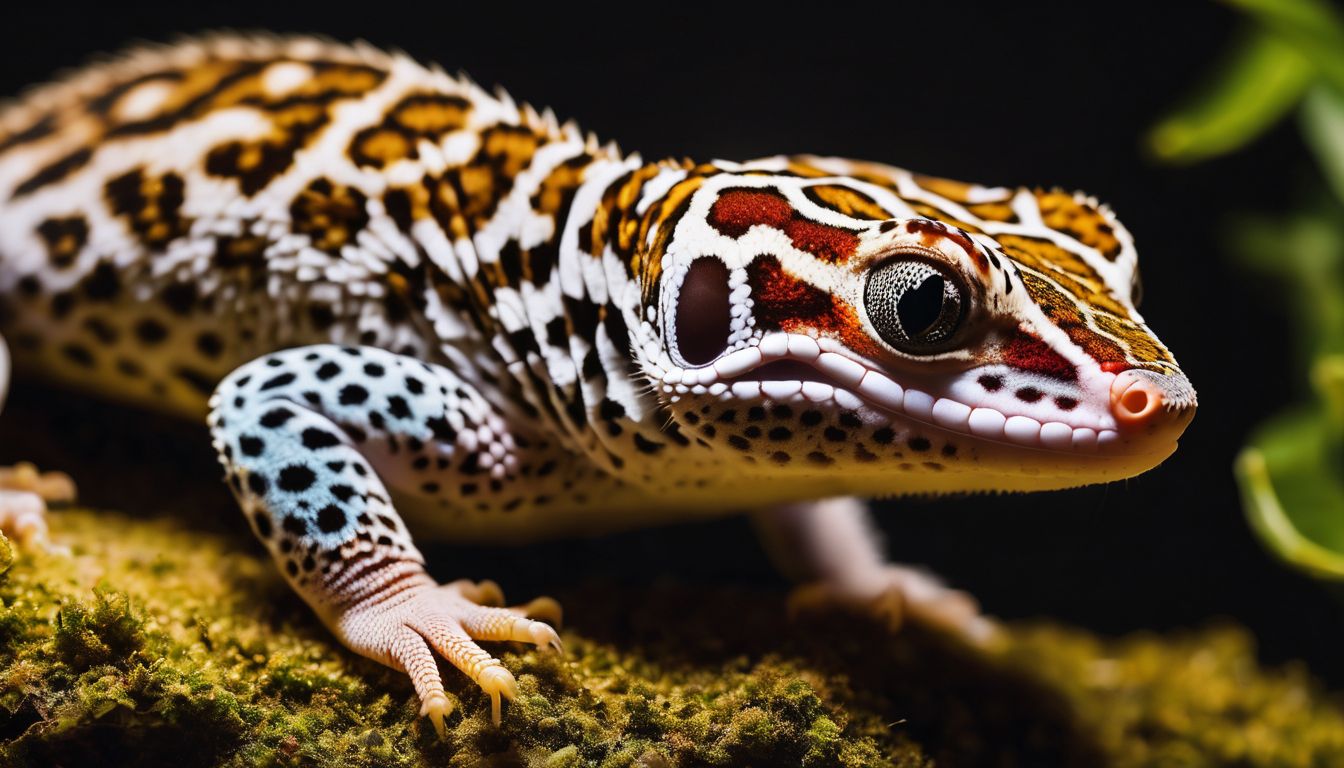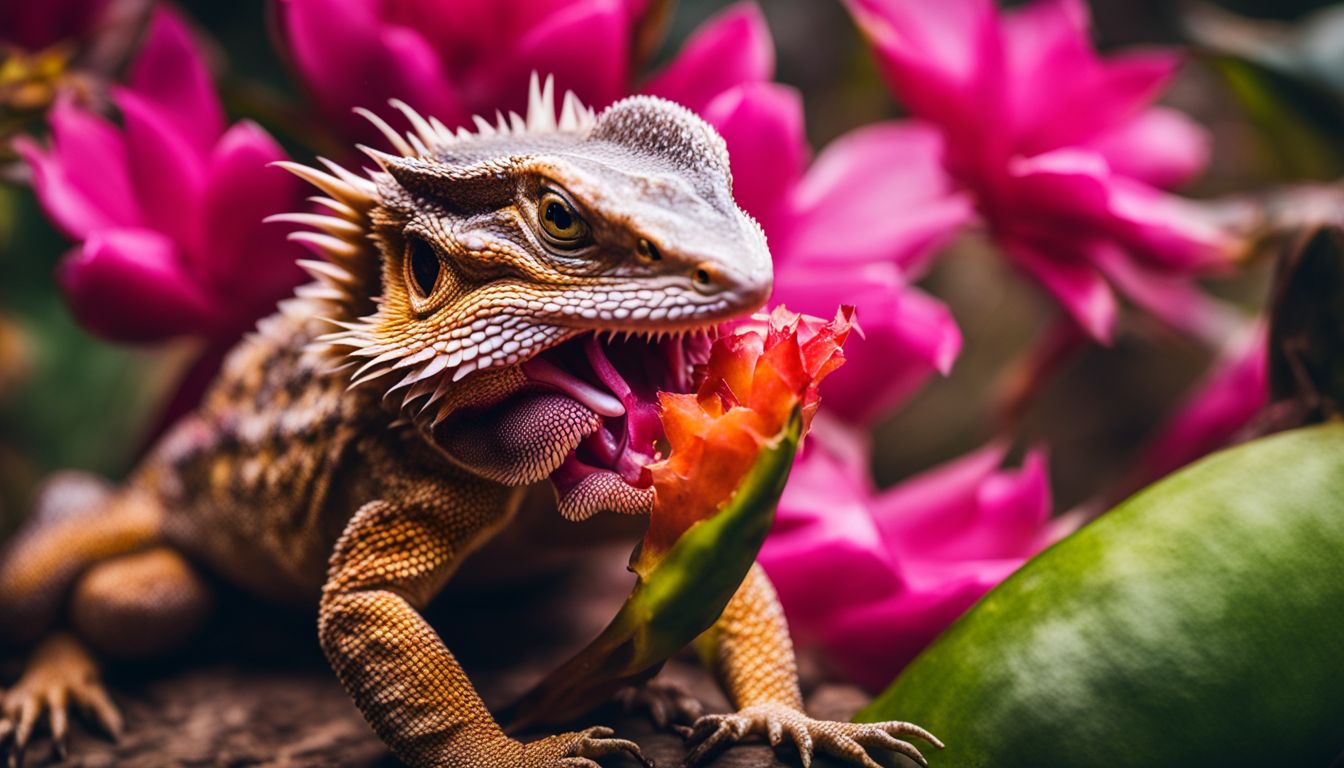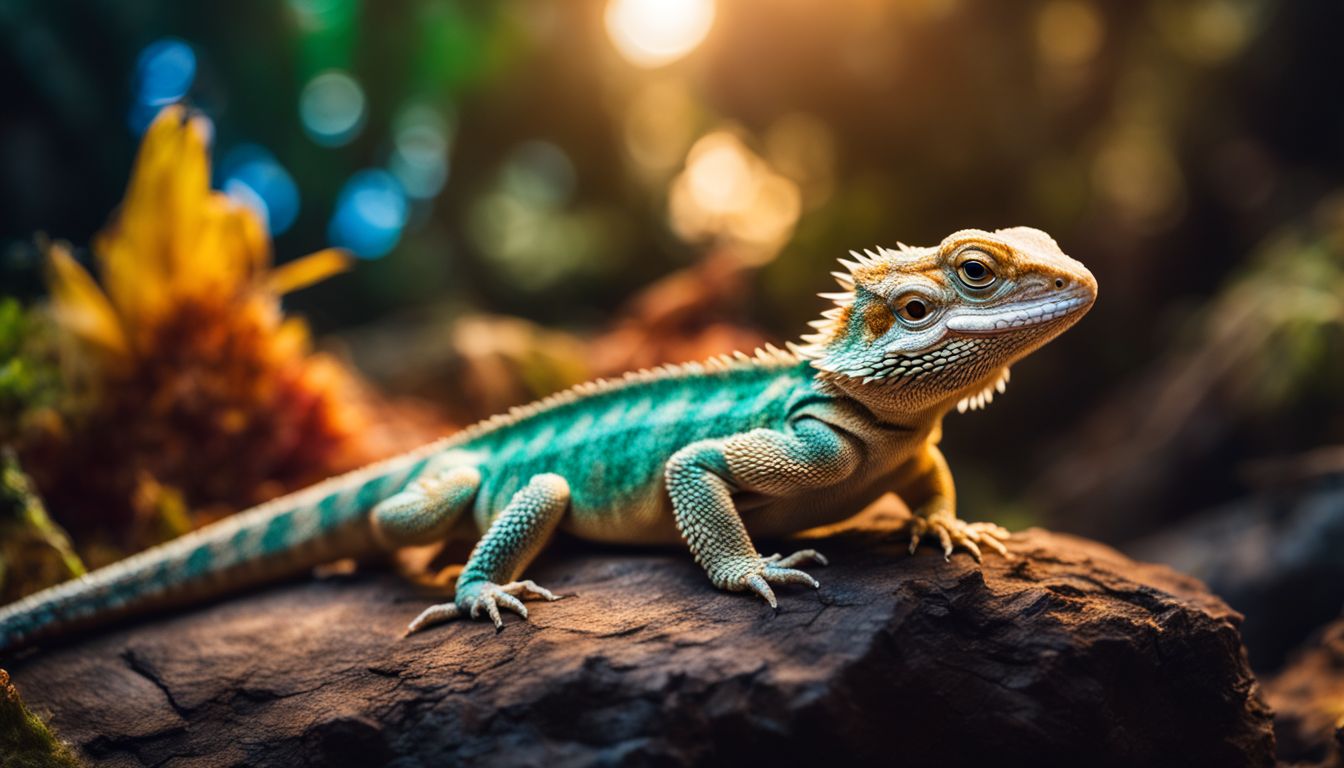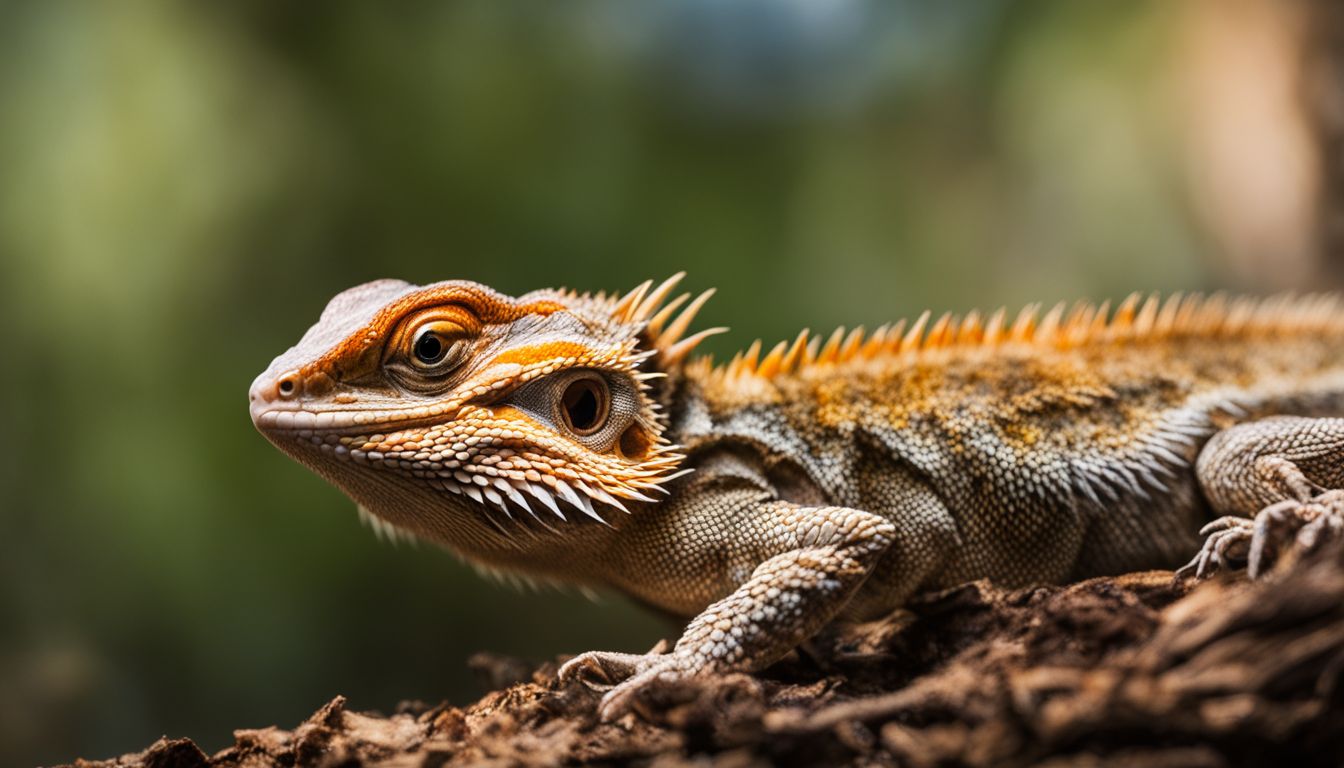Have you ever flicked off the lights and noticed your leopard gecko seem just as active as it was during the day? This might lead you to wonder, can these intriguing reptiles actually see in the dark? Many pet owners are curious about their nocturnal friends‘ mysterious night-time behaviors.
Leopard geckos have a knack for spotting their dinner even when it seems too dim for anything to be seen. That’s because they’re equipped with eyes that are up to 350 times more sensitive to light than ours! Our upcoming article will shed some light on how leopard geckos navigate their twilight world.
Get ready to peek into the fascinating vision of these night-time hunters!
Key Takeaways
- Leopard geckos have exceptional night vision, thanks to their eyes being 350 times more sensitive to light than human eyes, equipped with a high number of rods and specialized retinas allowing them to see in low-light conditions.
- Their eyes contain both rods and cones, enabling them to perceive color and movement even in the dark. The reflective layer called Tapetum Lucidum and large pupils further enhance their night vision capabilities.
- Providing suitable nighttime habitats with safe lighting options is crucial for leopard geckos’ well-being, as they are mainly nocturnal creatures. Safe lighting options include red or blue-colored lights that don’t disrupt their natural behaviors while observing these fascinating reptiles at night.
Understanding Leopard Geckos’ Vision

Leopard geckos have excellent night vision, allowing them to see in low light conditions. Their eyes contain both rods and cones, which help them perceive color and movement even in the dark.
The Role of Rods and Cones
In the eyes of leopard geckos, rods and cones play a big part in how they see. Rods are great for seeing in dim light. Leopard geckos have lots of them which helps them hunt at night.
They can spot their prey in lowlight conditions because rods let them pick up small amounts of light.
Cones help with seeing colors during the day. Even though leopard geckos are active mainly when it’s dark, having cones means they can also see well when there is some light around.
Their amazing eyes can adjust to different kinds of lighting, making these small creatures excellent hunters any time of day or night.
Comparing Gecko and Human Night Vision
Leopard geckos see way better at night than people. Their eyes can spot things in low light that we would miss. This is because they have lots of rods in their eyes, and these are great for seeing when it’s dark.
A human eye isn’t as good when the light is dim. We need more light to see clearly.
Gecko eyes are special too. They have large pupils which let in more light, making them about 350 times better at seeing in the dark than us! So while we might need a flashlight to find our way at night, leopard geckos can hunt and look around without any extra help from lights.
The Science Behind their Sight
Leopard geckos have a specialized layer in their eyes called the tapetum lucidum that reflects light, enhancing their night vision. Their large pupils and specialized iris also contribute to their ability to see in low light conditions.
Tapetum Lucidum: A Reflective Layer
Geckos have a cool trick in their eyes called the tapetum lucidum. It’s like a mirror inside their eyeballs that helps them see better at night. When light comes into their eye and hits this layer, it bounces back through their eyes again.
This gives them a second chance to see something in the dark.
Having the tapetum lucidum makes gecko eyes super good at catching light, much better than our own eyes. That’s why they can spot bugs to eat in really low light when we would just see darkness.
Their sharp night vision is key for hunting after sunset and staying safe from nighttime predators.
Large Pupils and a Specialized Iris
Leopard geckos have large pupils and a specialized iris that contribute to their exceptional night vision. Their big, dark eyes let in more light, helping them see clearly in low-light conditions.
These features allow the geckos to detect movement and hunt for prey during the night when their natural instincts kick in. The specialized structure of their iris helps control the amount of light entering the eye, ensuring they can adapt swiftly to changing light levels while navigating through dimly lit environments.
Observing Leopard Geckos at Night
When observing leopard geckos at night, it’s important to provide safe lighting options for nighttime viewing and understand their feeding practices in low light conditions. Providing the proper nighttime habitats and heat sources that don’t emit light is crucial for their well-being.
Safe Lighting Options for Nighttime Viewing
When setting up nighttime viewing for your leopard gecko, opt for red or blue-colored lighting. These colors don’t disturb their natural behaviors and allow you to observe them without disrupting their sleep.
Avoid bright white lights as they can negatively impact the gecko’s nocturnal habits and stress them out. Implementing these safe lighting options not only ensures a comfortable environment for your pet but also supports their natural behavior in low-light conditions.
Geckos have specialized eyes adapted to dim light, so it’s important to provide suitable lighting that won’t interfere with their nighttime activities. Red and blue lights help maintain a nocturnal environment while allowing you to enjoy observing your leopard gecko during its active hours at night.
Feeding Practices in Low Light Conditions
Leopard geckos rely on their exceptional night vision to hunt for food in low light conditions. When it comes to feeding them in dimly lit environments, it’s crucial to ensure that they can easily locate and consume their prey.
To do this, you can use brightly colored insects or dust their food with calcium powder, making it easier for the gecko to spot and ingest its meal. Additionally, providing shallow feeding dishes for easy access during nighttime hours contributes to their successful feeding practices under low light conditions.
These simple adjustments help support the leopard gecko’s natural hunting capabilities and ensure they receive proper nourishment even in darkened settings.
The Importance of Darkness for Leopard Geckos
Providing Proper Nighttime Habitats
Heat Sources That Don’t Emit Light
Providing Proper Nighttime Habitats
Leopard geckos need the right environment for their nighttime activities. They require a dark and quiet space to feel safe and comfortable, as they are mostly nocturnal creatures. To create a suitable habitat, use red or blue low-wattage bulbs instead of bright white lights.
These colors don’t disrupt their natural behavior and help maintain their night vision. Additionally, ensure that the temperature is optimal in their habitat by using heat sources that emit minimal light, such as under-tank heaters or ceramic heat emitters.
By offering them an appropriate nighttime environment, you can help leopard geckos thrive in their natural nocturnal habits.
Heat Sources That Don’t Emit Light
Leopard geckos need heat to stay healthy, even at night. You can use ceramic heat emitters or under-tank heating pads that produce warmth without emitting light. These are perfect for creating a cozy nighttime environment for your gecko without disturbing their natural behavior.
It’s important to provide the right amount of heat without overwhelming them, as leopard geckos thrive in consistent and moderate temperatures during the night.
Now let’s delve into the reasons why darkness is vital for leopard geckos’ well-being.
Conclusion
In conclusion, leopard geckos have remarkable night vision abilities due to their specialized eyes. They can see well in low-light conditions and are efficient nighttime hunters. Providing them with proper nighttime habitats and safe lighting options is crucial for their well-being.
Understanding and appreciating their exceptional night vision capabilities is essential for keeping these fascinating reptiles healthy and thriving in captivity. By creating suitable environments that cater to their unique visual adaptations, we can ensure that leopard geckos lead fulfilling lives in our care.
FAQs
1. Can leopard geckos see in the dark?
Yes, leopard geckos have excellent night vision which allows them to see in the dark.
2. What factors contribute to a leopard gecko’s night vision ability?
A leopard gecko’s exceptional night vision is due to their large eyes, vertical pupils, and specialized retinas that are sensitive to low light.
3. Do leopard geckos rely on other senses besides sight at night?
Aside from their vision, leopard geckos also use their sense of smell and touch to navigate and hunt during the night.
4. Can bright lights or flashlights harm a leopard gecko’s eyes due to their sensitivity in low light conditions?
Exposing a leopard gecko to bright lights or flashlights for extended periods can be harmful as it can disrupt their natural adaptation for low-light environments and cause stress.
5. How does a better understanding of a leopard gecko’s night vision benefit owners?
Understanding the unique abilities of a leopard gecko’s night vision helps owners provide suitable habitat conditions with appropriate lighting for these nocturnal creatures.




